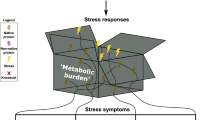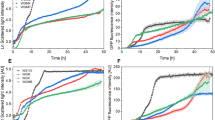Abstract
Production of recombinant proteins is an industrially important technique in the biopharmaceutical sector. Many recombinant proteins are problematic to generate in a soluble form in bacteria as they readily form insoluble inclusion bodies. Recombinant protein solubility can be enhanced by minimising stress imposed on bacteria through decreasing growth temperature and the rate of recombinant protein production. In this study, we determined whether these stress-minimisation techniques can be successfully applied to industrially relevant high cell density Escherichia coli fermentations generating a recombinant protein prone to forming inclusion bodies, CheY–GFP. Flow cytometry was used as a routine technique to rapidly determine bacterial productivity and physiology at the single cell level, enabling determination of culture heterogeneity. We show that stress minimisation can be applied to high cell density fermentations (up to a dry cell weight of >70 g L−1) using semi-defined media and glucose or glycerol as carbon sources, and using early or late induction of recombinant protein production, to produce high yields (up to 6 g L−1) of aggregation-prone recombinant protein in a soluble form. These results clearly demonstrate that stress minimisation is a viable option for the optimisation of high cell density industrial fermentations for the production of high yields of difficult-to-produce recombinant proteins, and present a workflow for the application of stress-minimisation techniques in a variety of fermentation protocols.





Similar content being viewed by others
References
Åkerlund T, Nordström K, Bernander R (1995) Analysis of cell size and DNA content in exponentially growing and stationary-phase batch cultures of Escherichia coli. J Bacteriol 177:6791–6797
Alfasi S, Sevastsyanovich Y, Zaffaroni L, Griffiths L, Hall R, Cole J (2011) Use of GFP fusions for the isolation of Escherichia coli strains for improved production of different target recombinant proteins. J Biotechnol 156:11–21
Carvalho RJ, Cabrera-Crespo J, Tanizaki MM, Goncalves VM (2012) Development of production and purification processes of recombinant fragment of pneumococcal surface protein A in Escherichia coli using different carbon sources and chromatography sequences. Appl Microbiol Biotechnol 94:683–694
Cormack BP, Valdivia RH, Falkow S (1996) FACS-optimized mutants of the green fluorescent protein (GFP). Gene 173:33–38
Cote RJ (2010) Media composition, microbial, laboratory scale. In: Flickinger MC (ed) Encyclopedia of industrial biotechnology, bioprocess, bioseparation, and cell technology. Wiley, New York, pp 3277–3297
García-Fruitós E, González-Montalbán N, Morell M, Vera A, Ferraz RM, Arís A, Ventura S, Villaverde A (2005) Aggregation as bacterial inclusion bodies does not imply inactivation of enzymes and fluorescent proteins. Microb Cell Fact 4:27
Jones JJ, Bridges AM, Fosberry AP, Gardner S, Lowers RR, Newby RR, James PJ, Hall RM, Jenkins O (2004) Potential of real-time measurement of GFP-fusion proteins. J Biotechnol 109:201–211
Jones JJ (2007) Green fluorescent protein as an analytical tool to dissect the physiology of recombinant protein production in fermenters. PhD thesis, University of Birmingham, Birmingham
Luo Q, Shen YL, Wei DZ, Cao W (2006) Optimization of culture on the overproduction of TRAIL in high-cell-density culture by recombinant Escherichia coli. Appl Microbiol Biotechnol 71:184–191
Martínez-Alonso M, García-Fruitós E, Ferrer-Miralles N, Rinas U, Villaverde A (2010) Side effects of chaperone gene co-expression in recombinant protein production. Microb Cell Fact 9:64
Miroux B, Walker JE (1996) Over-production of proteins in Escherichia coli: mutant hosts that allow synthesis of some membrane proteins and globular proteins at high levels. J Mol Biol 260:289–298
Moore JT, Uppal A, Maley F, Maley GF (1993) Overcoming inclusion body formation in a high-level expression system. Protein Expr Purif 4:160–163
Müller S, Nebe-von-Caron G (2010) Functional single-cell analyses: flow cytometry and cell sorting of microbial populations and communities. FEMS Microbiol Rev 34:554–587
Overton TW (2014) Recombinant protein production in bacterial hosts. Drug Discov Today (in press). doi:10.1016/j.drudis.2013.11.008
Pflug S, Richter SM, Urlacher VB (2007) Development of a fed-batch process for the production of the cytochrome P450 monooxygenase CYP102A1 from Bacillus megaterium in E. coli. J Biotechnol 129:481–488
Reuter M, Hayward NJ, Black SS, Miller S, Dryden DT, Booth IR (2013) Mechanosensitive channels and bacterial cell wall integrity: does life end with a bang or a whimper? J R Soc Interface 11:20130850. doi:10.1098/rsif.2013.0850
Saïda F, Uzan M, Odaert B, Bontems F (2006) Expression of highly toxic genes in E. coli: special strategies and genetic tools. Curr Protein Pept Sci 7:47–56
Sambrook J, Fritsch EF, Maniatis T (1987) Molecular cloning: a laboratory manual, 2nd edn. Cold Spring Harbor Press, Cold Spring Harbor, NY
Schneider CA, Rasband WS, Eliceiri KW (2012) NIH Image to ImageJ: 25 years of image analysis. Nat Methods 9:671–675
Sevastsyanovich Y, Alfasi S, Overton T, Hall R, Jones J, Hewitt C, Cole J (2009) Exploitation of GFP fusion proteins and stress avoidance as a generic strategy for the production of high-quality recombinant proteins. FEMS Microbiol Lett 299:86–94
Singh SM, Panda AK (2005) Solubilization and refolding of bacterial inclusion body proteins. J Biosci Bioeng 99:303–310
Sørensen HP, Mortensen KK (2005) Soluble expression of recombinant proteins in the cytoplasm of Escherichia coli. Microb Cell Fact 4:1
Strandberg L, Andersson L, Enfors S (1994) The use of fed batch cultivation for achieving high cell densities in the production of a recombinant protein in Escherichia coli. FEMS Microbiol Rev 14:53–56
Studier FW (1991) Use of bacteriophage T7 lysozyme to improve an inducible T7 expression system. J Mol Biol 219:37–44
Tseng CL, Leng CH (2012) Influence of medium components on the expression of recombinant lipoproteins in Escherichia coli. Appl Microbiol Biotechnol 93:1539–1552
Valgepea K, Adamberg K, Seiman A, Vilu R (2013) Escherichia coli achieves faster growth by increasing catalytic and translation rates of proteins. Mol BioSyst 9:2344–2358
Waldo GS, Standish BM, Berendzen J, Terwilliger TC (1999) Rapid protein-folding assay using green fluorescent protein. Nat Biotechnol 17:691–695
Wallace R, Holms W (1986) Maintenance coefficients and rates of turnover of cell material in Escherichia coli ML308 at different growth temperatures. FEMS Microbiol Lett 37:317–320
Walsh G (2010) Biopharmaceutical benchmarks. Nat Biotechnol 28:917–924
Want A, Thomas OR, Kara B, Liddell J, Hewitt CJ (2009) Studies related to antibody fragment (Fab) production in Escherichia coli W3110 fed-batch fermentation processes using multiparameter flow cytometry. Cytom A 75:148–154
Zhang JD, Li AT, Xu JH (2010) Improved expression of recombinant cytochrome P450 monooxygenase in Escherichia coli for asymmetric oxidation of sulfides. Bioprocess Biosyst Eng 33:1043–1049
Acknowledgements
This work was supported by a UK Biotechnology and Biological Sciences Research Council PhD studentship to CW. We thank Yanina Sevastsyanovich and Tania Selas Castiñeiras for helpful comments on the manuscript.
Conflict of interest
The BD Accuri C6 flow cytometer was awarded to TWO by the BD Accuri Creativity Award. TWO was paid speakers expenses by BD for speaking at a BD Accuri users’ event. The funders played no role in the design or implementation of this study.
Author information
Authors and Affiliations
Corresponding author
Electronic supplementary material
Below is the link to the electronic supplementary material.
Rights and permissions
About this article
Cite this article
Wyre, C., Overton, T.W. Use of a stress-minimisation paradigm in high cell density fed-batch Escherichia coli fermentations to optimise recombinant protein production. J Ind Microbiol Biotechnol 41, 1391–1404 (2014). https://doi.org/10.1007/s10295-014-1489-1
Received:
Accepted:
Published:
Issue Date:
DOI: https://doi.org/10.1007/s10295-014-1489-1




